Earth Puzzle
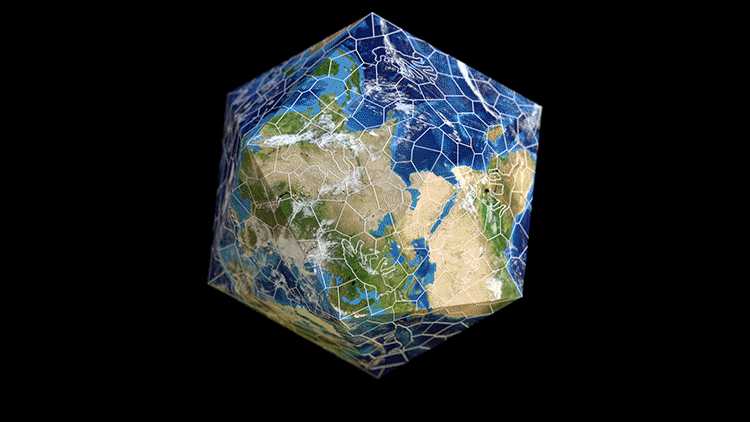
The Earth Puzzle is a map of the globe unlike any you’ve seen before.
Start anywhere and see where your journey takes you. This puzzle is
based on an icosahedral projection and has the topology of a sphere.
This means it has no edges, no North and South, and no fixed shape. Try
to get the landmasses together or see how the oceans are connected. Make
your own maps of the earth!
👇 🌎 👇
the Earth Puzzle from Nervous System on Vimeo.
WHIMSY PIECES
16 unique puzzle pieces shaped like animals from around the world
16 unique puzzle pieces shaped like animals from around the world
ARTWORK
Based on photographs from NASA's Earth Observatory which we transformed into an area-preserving icosahedral map projection
Based on photographs from NASA's Earth Observatory which we transformed into an area-preserving icosahedral map projection
INFINITY PUZZLE
infinitely reconfigurable, no edges, no fixed shaped!
infinitely reconfigurable, no edges, no fixed shaped!
950🌠
👇 🌎 👇
Earth Puzzle from Nervous System on Vimeo.
Earth and Moon Puzzles
Explore the Earth and Moon through our mind-bending, never-ending jigsaw puzzles. The Earth Puzzle
is a map of the globe unlike any you’ve seen before. Start anywhere and
see where your journey takes you. This puzzle is based on an
icosahedral map projection and has the topology of a sphere. This means
it has no edges, no North and South, and no fixed shape. Try to get the
landmasses together or see how the oceans are connected. Make your own
maps of the earth!
Map Projections
A classic map imposes distortions and orientations that reflect our
preconceived notions of the world. The Mercator projection, which is the
map we are most familiar with, unrolls the globe into a rectangle with
even spacing of latitude and longitude, inflating Greenland into a
massive tundra and smearing Antarctica into an unrecognizable white
smudge at the bottom. It makes it seem like the Arctic is impassably
vast, when actually flying over it is the fastest way to get to Europe
from the US. More subtly, it reinforces the idea of a world split into
West and East. Even a true globe typically has a fixed North-South axis,
forcing us into a certain viewpoint.
The Earth puzzle is based on
type of map called a polyhedral
projection, where the sphere is projected onto a shape with planar faces
and then unfolded flat. In this case, the globe is projected onto a
icosahedron, a 20 sided shape of equilateral triangles. This reduces the
distortion seen in most maps. This type of map was most famously
explored by Buckminster Fuller with his Dymaxion Map. However, unlike
the Dymaxion Map, our map is equal-area, meaning the relative size of
landmasses is preserved exactly.

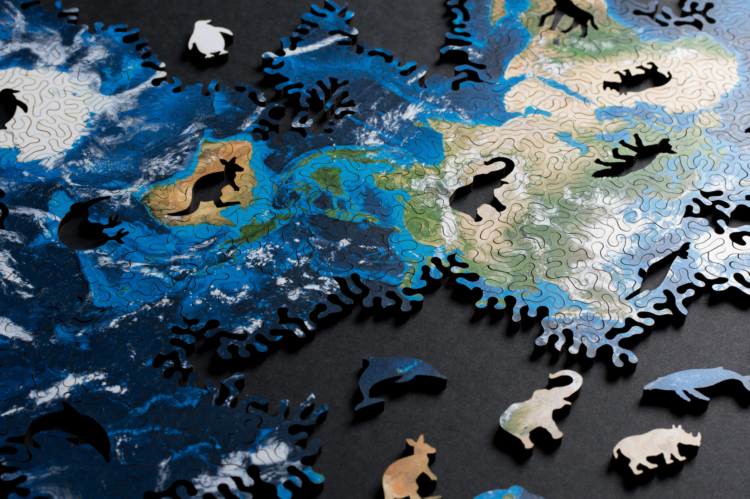
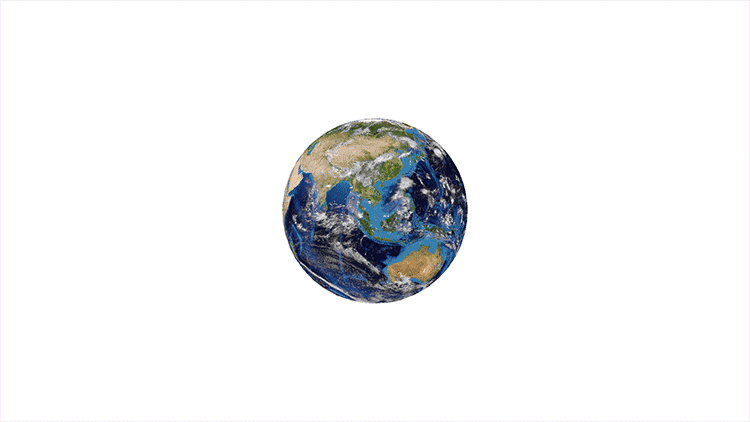
We created software to turn a Mercator projection into an icosahedral
one. This allowed us to transform photographs from NASA’s Earth
Observatory and Lunar Reconnaissance Orbiter into our icosahedral
mapping. We use a technique called spherical barycentric coordinates
to project the sphere onto the icosahedron. These are area coordinates
where every point on a triangle is identified as the weighted sum of its
3 vertices. If you take a point in a triangle and use that to subdivide
the triangle into three smaller triangles, then the weight associated
with each vertex is proportional to the area of the opposite triangle. Barycentric coordinates
are commonly used in computer graphics to interpolate quantities on
triangular meshes. You can extend this idea to spheres using spherical
triangular patches and their areas. By doing so, the same area on the sphere corresponds to a proportional area on the icosahedron.
The whole thing works in a GLSL shader. First we draw a triangle and
its barycentric coordinates. We use those coordinates to compute a point
on the sphere using spherical barycentric coordinates. From that point,
we get the latitude and longitude, which allows us to look up the
texture of a Mercator map.
We used the tool to design the projection such that the vertices of the icosahedron do not lay on land.
The vertices are the only fixed point of the puzzle, and a seam must
pass through them in order to make the puzzle flat. By putting the
vertices in the ocean, it means all continents can be assembled into
continuous shapes.
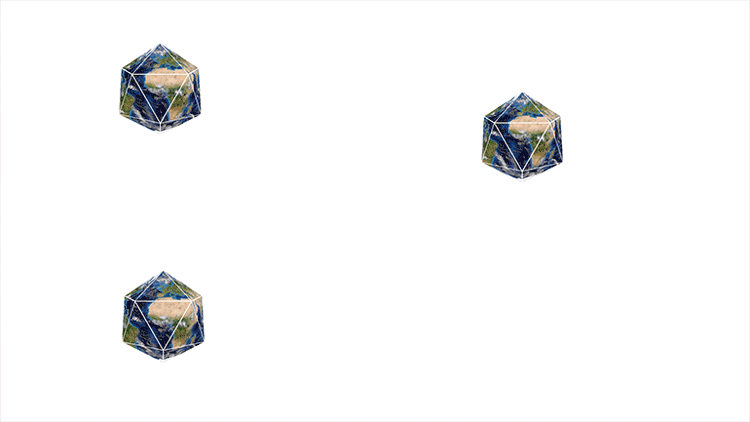
Infinity Puzzle
While Fuller always envisioned his Dymaxion Map as reconfigurable, we
take this one step further by making a 442 piece puzzle with no edges.
There is no fixed orientation or configuration of the puzzle. Assemble
it such that all the continents form an almost continuous land mass or
put all the oceans together. Put Antarctica in the center. This extends
the Infinity Puzzle concept we first introduced with the Infinite Galaxy Puzzle
(which has the topology of a Klein Bottle). The Infinity Puzzles are
puzzles that truly have no border: pieces wrap around connecting from
one part to another. There is no fixed final shape. The first Infinity
Puzzles tile, connecting the left to the right and the top to the
bottom. The Earth Puzzle’s pieces have more complex relationships, where
pieces rotate 60 degrees to zip the seams of the map in different ways.
This demonstrates how the infinity puzzles are not simply tiling
puzzles but represent a broader range of possible borderless puzzles.
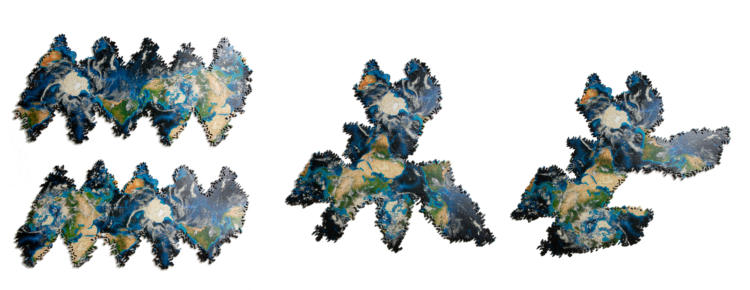
The
Earth Puzzle can be assembled into countless shapes because it has the
topology of a sphere and pieces wrap around with a rotation.
Growing the Puzzle Pieces in 3D

The puzzle pieces we generated for the Earth and Moon puzzles are similar to the maze pieces in our Geode Puzzles. However, there’s a fundamental difference: they had to be grown in 3D on the surface of an icosahedron.
To do this, we created a new version of our Maze system which is a
simulation of elastic rods. The puzzle piece edges grow, lengthening,
until they collide, pushing each other into contorted shapes. Because
the puzzle pieces are growing on a 3D surface, we have to unfold them to a flat pattern so they can be turned into a jigsaw puzzle.
Whimsy Pieces
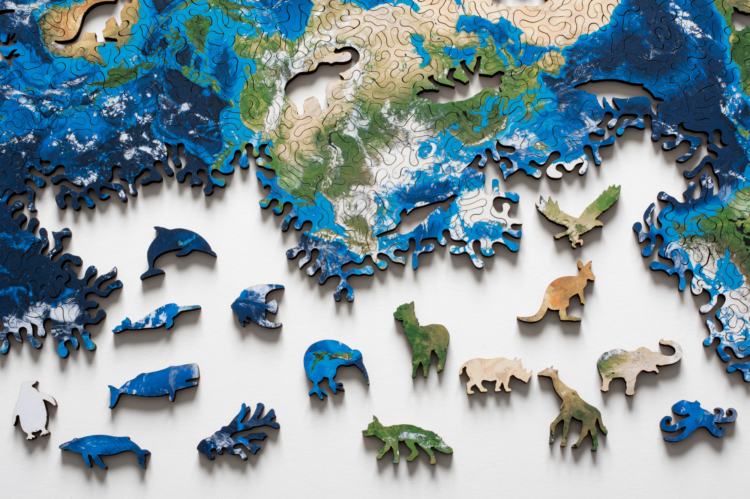
The Earth Puzzle includes 16 figure pieces shaped like animals
indigenous to different parts of the world: a kiwi on New Zealand, an
alpaca in South America, a giraffe and rhino in Africa, and different
whales and marine animals throughout the ocean.
Explore the Earth and Moon through our mind-bending, never-ending jigsaw puzzles. The Earth Puzzle
is a map of the globe unlike any you’ve seen before. Start anywhere and
see where your journey takes you. This puzzle is based on an
icosahedral map projection and has the topology of a sphere. This means
it has no edges, no North and South, and no fixed shape. Try to get the
landmasses together or see how the oceans are connected. Make your own
maps of the earth!

The Earth Puzzle has 442 pieces and costs $120. As a companion, we are also releasing the Moon Puzzle so
you can also explore lunar geography. The Moon Puzzle has 186 pieces
and costs $60. Both puzzles use imagery courtesy of NASA, the Earth from
the NASA Earth Observatory and the Moon from the Lunar Reconnaissance Orbiter.

The Earth and Moon Puzzles are for sale in our shop now along with our other Infinity Puzzles.


No comments:
Post a Comment